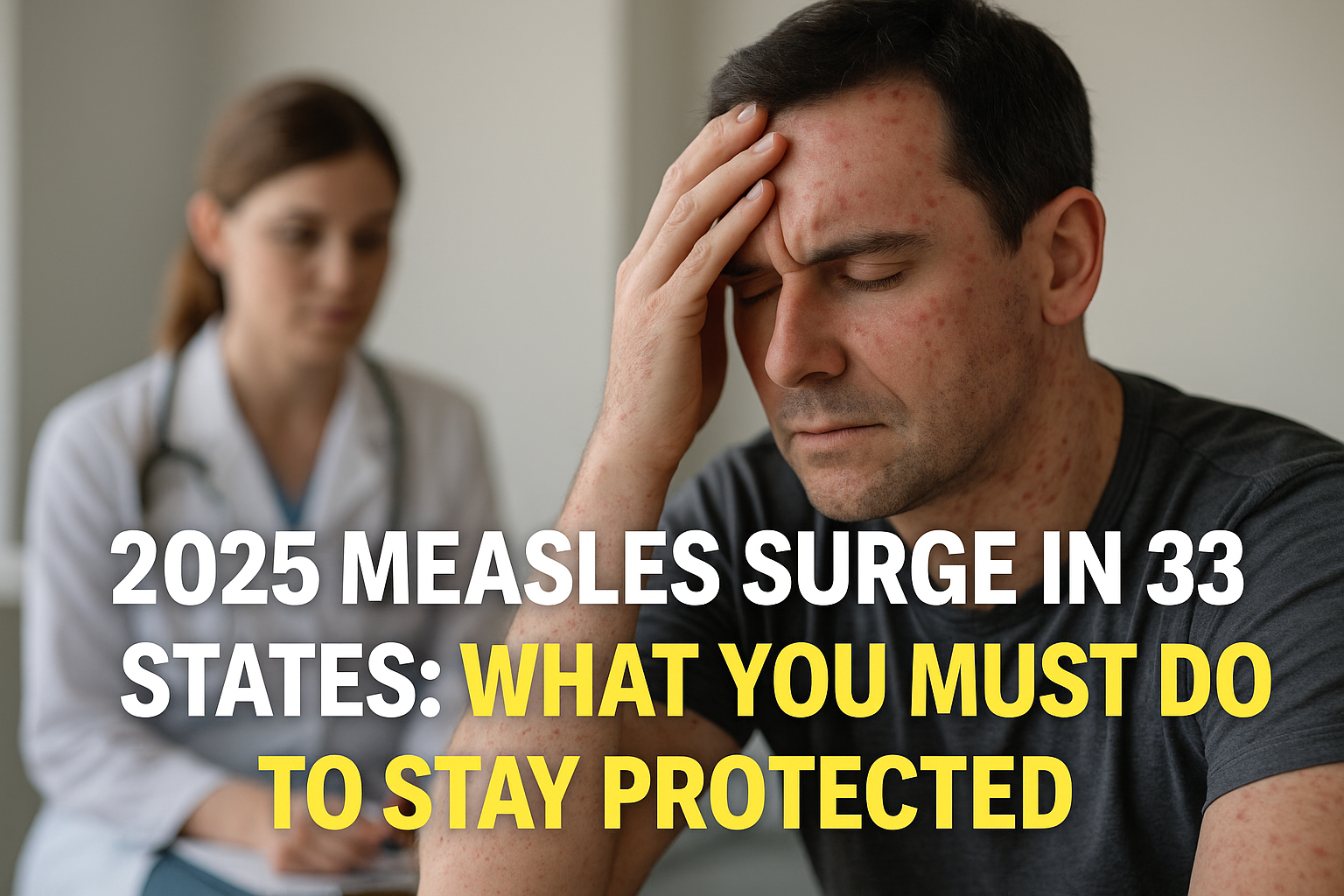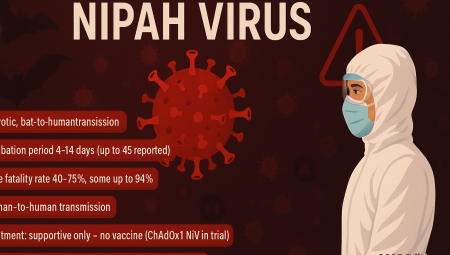As of mid-2025, measles cases are surging across 33 U.S. states—a shocking resurgence of a disease that was once nearly eradicated. This outbreak has raised public health concerns, especially among parents, frequent travelers, school communities, and immunocompromised individuals. In this comprehensive guide, we explain why measles is making a comeback, how it spreads, symptoms to watch for, how to protect yourself and your loved ones, and what public health officials are doing to contain the spread.
What Is Measles and Why Is It Back?
Measles is a highly contagious viral disease caused by the rubeola virus. It spreads through airborne respiratory droplets when an infected person coughs, sneezes, or even breathes nearby.
Despite being preventable through vaccination, the virus is resurging in 2025 due to:
- Decline in routine immunization rates, especially in children
- Misinformation and fear about vaccine safety on social media
- Pandemic-related disruptions in healthcare services
- Increased global travel and migration without adequate screening
- Delayed identification and reporting of cases
What Makes Measles So Dangerous?
The virus has a 90% transmission rate among non-immune individuals in close contact. Complications can include:
- Pneumonia
- Encephalitis (brain swelling)
- Severe diarrhea and dehydration
- Blindness
- Deafness
- Death (especially in children under 5 and adults over 20)
In communities with poor healthcare access, measles can overwhelm hospitals and clinics.
Which States Are Affected in 2025?
According to CDC reports and state health department updates, the following states have recorded significant case clusters:
- California
- Texas
- Florida
- New York
- Illinois
- Georgia
- Pennsylvania
- Michigan
- Arizona
- Washington
… and 23 more states with smaller but growing outbreaks. Large urban areas, public schools, daycare centers, and international airports are particularly vulnerable to rapid transmission.
CDC Watch Zones
In addition to the states listed above, the CDC has issued watch alerts for:
- College campuses with low vaccination compliance
- Tourist hotspots with international visitors
- Regions with known vaccine exemptions or misinformation hubs
How Does Measles Spread?
Measles is one of the most contagious human viruses. Here’s how it spreads:
- Airborne particles: The virus can live in the air and on surfaces for up to 2 hours after an infected person leaves.
- Surfaces and touch: Contaminated hands touching the nose, mouth, or eyes.
- Human contact: Even brief exposure to an infected person can result in transmission.
A person with measles is contagious four days before and four days after the rash appears, which means people often spread the virus before they realize they are sick.
Recognizing the Symptoms of Measles
Early detection is crucial to stopping the spread. Symptoms appear about 7–14 days after exposure.
Initial Symptoms:
- High fever (can spike to 104°F / 40°C)
- Dry cough
- Runny nose (coryza)
- Red, watery eyes (conjunctivitis)
- General fatigue and body aches
Progression Symptoms:
- Koplik spots: Small white spots with bluish centers inside the mouth
- Red, blotchy rash: Starts on the face, spreads to neck, torso, and limbs
Severe Symptoms (in some cases):
- Seizures
- Rapid breathing or respiratory distress
- Vomiting or diarrhea
Children, the elderly, and immunocompromised individuals may exhibit atypical symptoms and should be monitored closely.
Who Is Most at Risk?
- Infants and children under 5
- Pregnant women
- Immunocompromised individuals (cancer patients, HIV-positive persons)
- Unvaccinated adolescents and adults
- Healthcare workers and teachers
- International travelers
Why Are Unvaccinated People at Greater Risk?
The MMR (Measles, Mumps, Rubella) vaccine provides 93–97% effectiveness with two doses. People without vaccination lack any immunity, making them highly susceptible to infection and severe complications.
Even a single case in a school or community with low vaccination rates can trigger a wide-scale outbreak.
How to Protect Yourself from Measles in 2025
Get Vaccinated
- Children should receive two MMR doses (first at 12–15 months, second at 4–6 years)
- Adults born after 1957 should ensure they’ve had two doses or lab-confirmed immunity
- Travelers to outbreak zones should receive a booster shot if needed
Practice Effective Hygiene
- Wash hands with soap and water for at least 20 seconds
- Avoid touching your face (especially eyes, nose, and mouth)
- Use alcohol-based hand sanitizers when handwashing isn’t possible
Minimize Exposure
- Limit time in crowded indoor settings, especially with poor ventilation
- Postpone non-essential travel to outbreak-heavy areas
- Wear a high-quality mask in public transport or healthcare facilities
Support Your Immune Health
- Eat immune-boosting foods (vitamin C, zinc, probiotics)
- Stay well hydrated
- Get 7–9 hours of sleep nightly
- Avoid stress through mindfulness or exercise
Why Are Measles Cases Rising in 2025?
Why are measles cases rising in 2025?
Measles cases are increasing due to declining vaccination coverage, social media-driven vaccine hesitancy, and global travel. Many communities have pockets of unvaccinated individuals, allowing the virus to spread quickly and trigger outbreaks.
Pro Tips: Expert Advice to Stay Safe
- Check your immunization records—especially if you’re planning to travel or work with children.
- Ask your doctor about immunity titers if you’re unsure of your vaccine status.
- Advocate for school-wide vaccine compliance in your local community.
- Limit contact with symptomatic individuals, even if symptoms seem mild.
- Report suspected cases to local health authorities to trigger rapid contact tracing.
- Stay updated via CDC and WHO websites—they provide outbreak maps and real-time alerts.
- Organize local awareness events to promote measles education and vaccine facts.
FAQ: Common Questions About the Measles Outbreak
Can I get measles even if I’m vaccinated?
Yes, breakthrough infections can occur but are rare. Vaccinated individuals usually experience milder symptoms and a shorter illness duration.
Should adults get the MMR vaccine?
Yes. Adults who never received the vaccine or only got one dose should complete the two-dose schedule. Healthcare professionals, teachers, and travelers are especially encouraged.
Is it safe to vaccinate during an outbreak?
Absolutely. Vaccination remains the most effective way to control outbreaks and protect individuals and communities.
What should I do if I think I’ve been exposed?
Contact your healthcare provider. You may be eligible for post-exposure prophylaxis (PEP) such as MMR vaccine or immunoglobulin if seen within 72 hours of exposure.
How long does measles immunity last?
Generally lifelong if you’ve had the disease or received both vaccine doses. Routine boosters are not usually required.
Can measles be treated?
There is no antiviral treatment for measles. Supportive care includes fluids, fever reducers, and managing complications under medical supervision.
Conclusion
The rise in measles cases across 33 states is a public health emergency that demands action, awareness, and collective responsibility. This preventable disease continues to spread because of misinformation, under-vaccination, and systemic healthcare delays.
The power to stop measles lies in timely vaccination, rapid response, and community cooperation. Share accurate information, support local health initiatives, and don’t hesitate to speak with your healthcare provider if you have doubts.
Has your area been impacted by the measles outbreak? Share your experiences, thoughts, or preventive tips in the comments. Your voice could help raise awareness.



